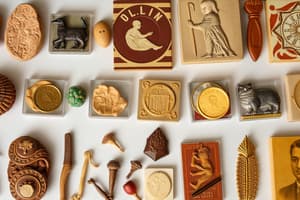Podcast
Questions and Answers
What is the difference between class and individual evidence?
What is the difference between class and individual evidence?
Class characteristics are not unique to a particular object but place the particular bit of evidence into a group of objects. Individual characteristics narrow down the evidence to a single, individual source.
What are examples of class versus individual evidence?
What are examples of class versus individual evidence?
- Hair (correct)
- Blue denim (correct)
- Fingerprints (correct)
- White cotton (correct)
How is the crime scene reconstructed?
How is the crime scene reconstructed?
By developing a likely sequence of events using physical evidence and statements made by individuals.
What is the significance of physical evidence?
What is the significance of physical evidence?
Why is evidence dried before packaging?
Why is evidence dried before packaging?
What is the Product Rule?
What is the Product Rule?
What is a druggist fold?
What is a druggist fold?
What type of evidence is found more often?
What type of evidence is found more often?
What types of evidence have databases? (Select all that apply)
What types of evidence have databases? (Select all that apply)
All evidence needs an evidence label and a _____ of custody.
All evidence needs an evidence label and a _____ of custody.
What is the importance of standards in evidence evaluation?
What is the importance of standards in evidence evaluation?
Flashcards are hidden until you start studying
Study Notes
Evidence Types
- Class Evidence: Non-unique characteristics that place evidence into general categories; more common than individual evidence.
- Individual Evidence: Unique characteristics that identify evidence down to a specific source, like fingerprints or specific paint layers.
Examples of Evidence
- Class Evidence: White cotton fibers, blue denim.
- Individual Evidence: Specific fingerprints, hair, or unique paint chips.
Crime Scene Reconstruction
- Involves developing a probable sequence of events through physical evidence and eyewitness statements.
- Sources of information include physical evidence, medical examiner reports, and detective notes.
Significance of Physical Evidence
- Helps narrow down suspects and understand the sequence of events in a crime.
- Can link a suspect to a witness or vice versa.
Evidence Packaging Protocol
- Evidence must be air-dried before packaging to prevent smudging and loss of crucial details.
Product Rule Calculations
- Convert percentages to decimals and multiply together; multiply by the relevant population for probability estimates.
- Example: For a population of 350, calculate using 45%, 20%, and 3% multiplied together.
Druggist Fold (Paper Bindle)
- A folded paper used for collecting trace evidence; steps include folding and securing with tape.
- Important for preserving the integrity of small evidence samples.
Evidence Evaluation
- Check if evidence is properly collected and packaged.
- Verify the chain of custody and labeling for all evidence.
Frequent Evidence Types
- Class evidence is encountered much more frequently in forensic investigations.
Databases for Evidence Types
- Fingerprint Database: IAFIS (Integrated Automated Fingerprint Identification System).
- DNA Database: CODIS (Combined DNA Index System).
- Ballistics Databases: NIBIN (National Integrated Ballistics Network) and IBIS (Integrated Ballistics Identification System).
- Vehicle Paint Database: PDQ (Forensic Automotive Paint Data Query).
- Shoe Print Database: SICAR (Shoe print Image Capture and Retrieval).
Evidence Collection Methods
- All evidence requires proper labeling and documentation of chain of custody.
- Biological Samples: Techniques vary for liquid, dried blood, semen, and saliva.
- Documents: Originals are essential, packaged separately to prevent damage.
- Drugs: Various methods for plants, powders, and prescriptions; always enclosed in suitable containers.
- Explosives: Handled by trained personnel; residues must be collected in appropriate containers.
- Fibers/Hairs: Collected with tools and packaged securely.
- Fingerprints: Collected using dust and tape methods.
- Firearms: Must be unloaded; packaged separately and securely.
- Glass: Packaged in protective containers or wrapped in cotton.
- Impressions: Photographed first and can be made using dental clay.
- Organic Samples: Collected with specific considerations for biohazard materials.
Importance of Standards in Evidence Evaluation
- Standards ensure consistent reactions during testing, validating the evidence being examined.
Studying That Suits You
Use AI to generate personalized quizzes and flashcards to suit your learning preferences.




